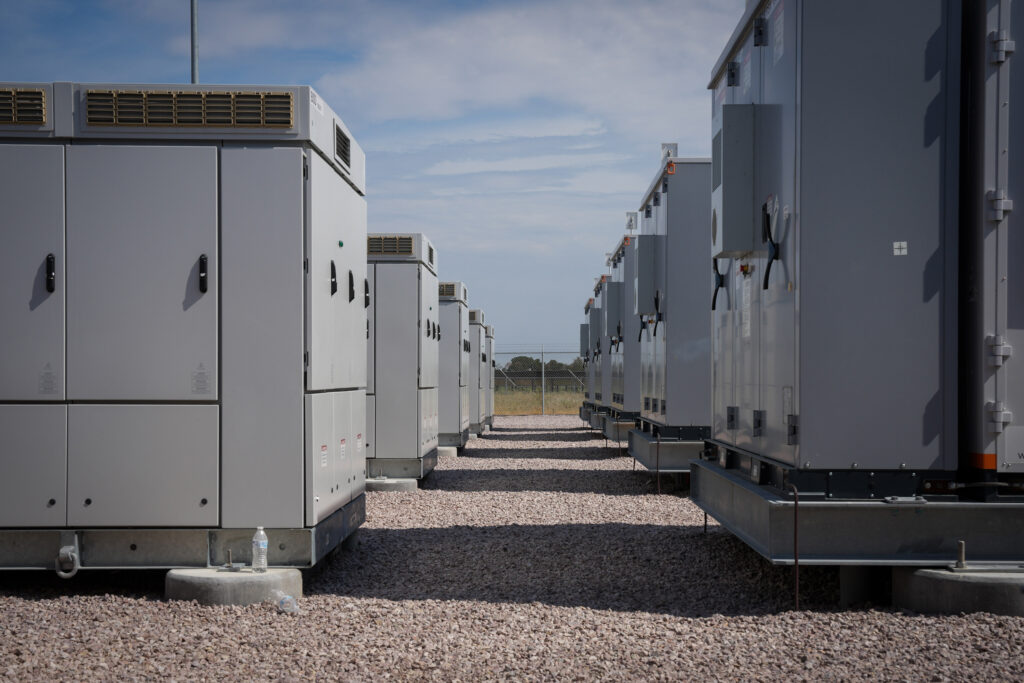Congress began tearing down the most consequential climate policy it had ever passed as torrents from a 1,000-mile-long atmospheric river lashed Washington, D.C.
The worst impacts of Tuesday’s storm were far up the Potomac River. Any concerns about how the United States would grapple with the increasingly intense weather of a warming world receded to background noise, less audible than the rain pelting the Capitol dome.
Republicans on the House Ways and Means Committee voted to repeal clean energy incentives early Wednesday after an all-night session marking up legislation they titled “One Big, Beautiful Bill.” The $4.9 trillion package would extend the tax cuts passed in President Donald Trump’s first term and add a few more, such as eliminating taxes on tips, while ramping up border security spending. A portion of the funds to pay for the bill—about 11 percent, according to the Joint Committee on Taxation’s tally—would come from eradicating tax credits passed in the Inflation Reduction Act of 2022 that were meant to spur a U.S. transition to cleaner energy.
Billions of dollars of private investment have poured into hundreds of new electric vehicle and battery plants and other clean energy projects in the wake of the IRA’s passage, with much of the boom occurring in Republican-led states. As President Joe Biden’s climate team left the White House, they expressed faith that this bipartisan impact would give the IRA durability, even though it had passed Congress with solely Democratic votes. The House Ways and Means Committee decisively put this notion to rest with its 389-page draft.
“Make no mistake, this bill takes a sledgehammer approach,” a coalition of environmental groups wrote in a letter to committee leaders. The legislation “guts America’s clean energy production, raises costs for families, worsens air pollution, and eliminates hundreds of thousands of good-paying manufacturing jobs – all to fund massive tax breaks for billionaires.”
The outnumbered Democrats on the committee focused their fight on the legislation’s other impacts—like its massive cuts to Medicaid and food assistance—with little or no mention of the energy tax credits. Republicans maintained that lowered taxes benefited the vast majority of ordinary Americans.
“The One Big Beautiful Bill is the key to making America great again,” said Rep. Jason Smith, R-Mo., chairman of the Ways and Means Committee. “This bill wasn’t drafted by special interests or K Street lobbyists. It was drafted by the American people in communities across the country.” Smith talked about mothers, farmers and owners of small businesses who lauded the tax cuts during field hearings committee Republicans held last year. But certainly big business lobbyists also liked the package, including the American Petroleum Institute, which called it a plan “that supports American energy leadership.”
This committee vote is just the first step in a long, byzantine process known as “budget reconciliation,” special legislation that has an easier path to passage because it only requires a simple majority in the Senate. In the past decade, nearly all major policy, including the IRA, has been enacted through this route.
The bill will be changed before it hits the president’s desk because of bitter disputes among Republicans over the so-called SALT deduction cap in states with high state and local taxes and over public lands in the West. But whether any of the clean energy incentives can be saved in this process will depend largely on the clout of a few Republicans who have dared to voice support for them amid Trump’s vocal campaign to end what he calls the “new green scam.”
Here are the main points to know about the politics, the people to watch and the huge potential consequences for climate change.
“The Most Complicated Venn Diagram”
Clean energy advocates were heartened two months ago when 21 House Republicans sent Smith a letter urging his committee to maintain support for the energy tax credits that were spurring economic development in their districts. Given the Republicans’ narrow majority, their no votes could sink any attempt at repeal.
But fissures began to emerge, with some of the would-be Republican clean energy champions concerned primarily with the biofuels incentives that are popular in farm country. Biofuel tax credits were the only climate policy that got a boost from the House Ways and Means committee; it extended them to 2031, four years beyond their original expiration date.
Faring worst in the legislation were consumer credits, like those for the purchase of electric vehicles, home efficiency upgrades or solar installations; all would expire by year’s end.
“Basically the suite of consumer-focused credits is just being torn out root and branch, everything from stuff that’ll help people better insulate their homes, to get solar on the roofs, to find more cost effective transportation,” said Harry Godfrey, managing director of Advanced Energy United, which lobbies for the clean energy industry. “These are all the tools that people are using to help manage rising energy and transportation costs. We’re taking those tools away from people at a time of rising costs—that is dangerous and problematic in and of itself.”
“I will emphasize this is a starting point and it’s very unlikely this version will become law. However, a lot of this could become law, and that’s the concerning thing.”
— Chris Moyer, Echo Communications
But the Republican leadership framed clean energy incentives as something solely of interest to the upper classes, naming this section of the legislation, “Working Families Over Elites.” (In fact, Democrats had designed the IRA to extend the benefits of clean energy to working class communities, offering tax credits for used EVs for the first time and providing bonus tax credits for projects located near old fossil fuel industry sites or in low-income communities.)
The tax credits that go to businesses and investors are eliminated more slowly, with phase-out of most beginning in 2029. But since the consumer credits would help generate the market demand that developers and producers are relying on, the extra time may not help.
“This is the first concrete act of this Congress to attempt to dismantle these tax credits, and a lot of folks in the industry were hoping for a better starting point,” said Chris Moyer, a former Democratic staffer on Capitol Hill and the founder of Echo Communications, who now advises clean energy companies. “I will emphasize this is a starting point and it’s very unlikely this version will become law. However, a lot of this could become law, and that’s the concerning thing.”
He and other clean energy advocates will argue that withdrawing support for new energy projects is at odds with Trump’s energy abundance and dominance themes. The vulnerable tax credits are especially important for forms of energy that Republicans say they support, like nuclear and advanced geothermal developments, that need a long lead time.
So far, Republicans have put the big Trump tax cuts first. Rep. Claudia Tenney (R-NY), who called in March for preservation of the energy tax credits, voted with her fellow GOP members on Ways and Means to repeal them, even while noting that she would have liked government support maintained for the four nuclear power stations in her upstate district. “Individual priorities do not take precedence over ensuring American families, workers and businesses do not face tax hikes in 2026,” she said.
Godfrey said that if repeal of the clean energy tax credits were a standalone bill, he did not see how it could get out of the House or Senate. But the dynamic is more difficult when Republican supporters of clean energy would have to stand in the way of Trump’s promised tax cuts.
“The politics are incredibly complicated, and [it] creates an incredible amount of pressure on a member to really hone in on their particular priorities,” Godfrey said. He said advocacy on the measure involves putting together “the most complicated Venn diagram in the world” to figure out how to build a coalition of votes that can make a difference.
“The question really does become, are enough members going to say, ‘This is the hill I’m going to die on?’” Godfrey said. “That is hard to discern.”
In the coming weeks, much attention will be on the four Republican senators who last month signed a letter to Senate Majority Leader John Thune of Missouri voicing support for the energy tax credits: Lisa Murkowski of Alaska, Thom Tillis of North Carolina, John Curtis of Utah and Jerry Moran of Kansas. It is seen as a critical mass of support, since Republicans can afford to lose no more than three votes in the Senate, given their 53-47 majority.
Although they emphasized only one set of clean energy incentives in their letter—the investment tax credits—advocates hope they also will support the entire suite of consumer incentives as well, since they help generate the market demand that the producers rely on.
“As constituents share their practical economic benefits of going solar, we are confident that their senators will fix the House’s extreme and reckless budget,” said Glen Brand, vice president for policy and advocacy for Solar United Neighbors.
Pressure Points
Moyer, however, wrote in a recent note that he is concerned that only four Republican Senators have stepped forward in favor of clean energy policy, and he said it is clear from their letter that they want to work behind the scenes instead of forcing a showdown on the Senate floor. He is urging clients to ramp up public pressure and hold in-district press events until the days that votes are taken.
“The message has to be that you can’t let up,” Moyer told Inside Climate News. “And the folks who I think are the most influential at this moment are the CEOs of companies in various districts that have projects that are underway or about to be underway, and the workers in these districts. Whether it’s in Georgia or Arizona or New York or anywhere else, it’s trying to make clear to their members of Congress that there’s a lot on the line here.”
The automotive sector, in particular, has much to lose after investing billions of dollars in a transition to EVs. “The politics change very quickly, and automakers change very slowly,” said Sean Tucker, lead editor for Kelley Blue Book. “It’s really difficult for them to make adjustments when they’re working on a seven- to 10-year design cycle.”
But the automakers’ main lobbying group, the Alliance for Automotive Innovation, has been silent so far on the budget reconciliation bill, even after speaking out on other big policy changes in recent weeks, voicing support for rollback of California’s greenhouse gas emissions regulations and opposition to Trump’s tariffs.
This story is funded by readers like you.
Our nonprofit newsroom provides award-winning climate coverage free of charge and advertising. We rely on donations from readers like you to keep going. Please donate now to support our work.
Donate Now
General Motors, Ford, Stellantis and other big carmakers are members of one of the nation’s biggest business lobbying groups, the National Association of Manufacturers, which praised the House Ways and Means bill as “a vital step forward in securing a competitive tax environment that empowers manufacturers to create jobs, invest, grow and compete.” NAM said Trump’s 2017 tax cut bill, which lowered the top corporate tax rate from 35 percent to 21 percent, was “rocket fuel for manufacturers” and the new provisions get the sector closer to an effective 15 percent tax rate.
The advocacy group Americans for Prosperity, heavily financed by the petrochemical monolith Koch Industries, is running advertisements on TV in Washington declaring the decision on the budget reconciliation bill boils down to a “simple” equation.
“Lowering tax bills for hardworking families? Good. Reckless spending on green energy fantasies? Not good,” the ad says. “Eliminating Joe Biden’s Green New Deal helps pay for Trump’s tax cuts.”
The word “helps” is doing heavy lifting in the ad, given that the Joint Committee on Taxation’s calculation is that eliminating the energy tax credits saves about $559 billion, a small fraction of the $4.9 trillion cost of the tax cut package. (The JCT’s estimate is nearly double the original estimated cost of the IRA’s clean energy tax credits, the value of which always depended on how much interest they generated among developers.)
And if the only motivation for repeal of the energy tax credits were to pay for Trump’s tax cuts, it doesn’t explain why the House Ways and Means Republicans took other steps that have no revenue impact, like eliminating a provision in the IRA that allowed for “transferability” of tax credits, which widened the potential pool of investors for clean energy projects.
It will be challenging to make the case for renewable energy in a GOP-led Congress when the oil and gas industry, one of the biggest contributors to political campaigns, favored Republicans with 87 percent of its $75 million in donations in the 2025 election cycle. To combat that advantage, clean energy advocates on Capitol Hill are trying to make the business case for the clean energy incentives instead of focusing on their most profound potential—cutting greenhouse gas emissions from the nation’s economy to buffer Americans from the worst impacts of global warming.
Eliminating Incentives Could Have Stark Emissions Consequences
Repeal of all of the IRA tax credits, when combined with Trump’s planned rollback of regulations like power plant and vehicle emissions standards, would bring progress on cutting U.S. carbon emissions to a near standstill, according to recent modeling by the Rhodium Group.
Rhodium had not immediately calculated the impact of the House Ways and Means draft voted on in committee this week. But an analysis it completed late last year showed that U.S. greenhouse gas emissions could be as much as 35 percent higher in 2030 than the current trajectory under a complete elimination of the Biden-era climate policy. By 2035, emissions would be as much as 71 percent higher than the path under current tax incentives and regulations. Emissions would be flat or slightly lowered due to increased efficiency, a continued retreat from coal and some uptake in electric vehicles. But they would be nowhere near the goals set under the Paris climate accord for a 50 percent cut in emissions from 2005 levels by 2030 and 61 percent by 2035.

The impact of the tax repeals are sure to be felt in the marketplace, clean energy advocates say. The current version of the budget reconciliation bill “is going to chill investment, particularly in manufacturing and critical minerals processing, advanced nuclear, in a bunch of sort of cutting- edge stuff,” Godfrey said. “And it’s going to do it at a time when we really want to ramp that sort of work up.”
Like Rhodium’s analysts, Tucker, of Kelley Blue Book, sees the repeal of the tax credits as slowing rather than halting the transition to EVs in the United States. But he notes that it is happening at a time when other countries will be moving to EVs more rapidly. “I think in the long run, the industry is shifting toward EVs no matter what politicians do,” Tucker said. “This just slows the American companies down and potentially makes them less competitive.”
House Republicans say without their budget reconciliation bill, taxpayers on average would face a 22 percent tax increase next year once the original Trump tax cuts expire. They calculate their bill will deliver a $1,300 tax cut for the average American family.
But climate action advocates note that there will be new costs associated with repeal of the clean energy policy.
Jason Grumet, CEO of the American Clean Power Association, said the bill will significantly raise taxes on the fastest-growing energy sector. “It imposes a sudden policy shift that would raise energy costs, take paychecks away from tens of thousands of American workers, and harm the economies of small towns across the nation,” he said.
Rhodium estimates that household energy bills will be at least 7 to 12 percent higher in 2035 than they would have been under the Biden climate policies, although that doesn’t capture all of the latest research showing upward pressure on prices due to artificial intelligence and data centers.
And then there are the costs of unabated climate change itself, which have always been difficult to calculate. They will be more difficult still to assess in the years ahead, as the Trump administration is ending government tracking of the costs of severe weather events at the same time Congress is retreating from the only steps it has taken to fend off the worst impacts of global warming.
About This Story
Perhaps you noticed: This story, like all the news we publish, is free to read. That’s because Inside Climate News is a 501c3 nonprofit organization. We do not charge a subscription fee, lock our news behind a paywall, or clutter our website with ads. We make our news on climate and the environment freely available to you and anyone who wants it.
That’s not all. We also share our news for free with scores of other media organizations around the country. Many of them can’t afford to do environmental journalism of their own. We’ve built bureaus from coast to coast to report local stories, collaborate with local newsrooms and co-publish articles so that this vital work is shared as widely as possible.
Two of us launched ICN in 2007. Six years later we earned a Pulitzer Prize for National Reporting, and now we run the oldest and largest dedicated climate newsroom in the nation. We tell the story in all its complexity. We hold polluters accountable. We expose environmental injustice. We debunk misinformation. We scrutinize solutions and inspire action.
Donations from readers like you fund every aspect of what we do. If you don’t already, will you support our ongoing work, our reporting on the biggest crisis facing our planet, and help us reach even more readers in more places?
Please take a moment to make a tax-deductible donation. Every one of them makes a difference.
Thank you,


















